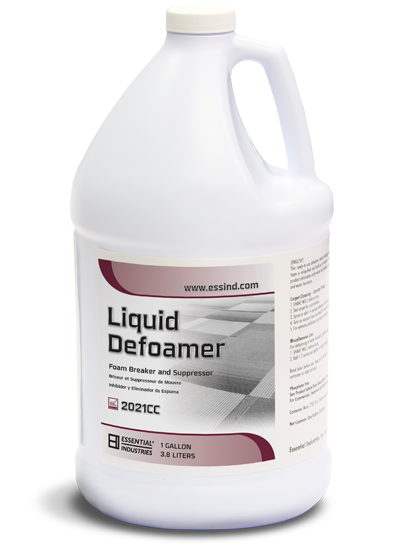The Function of Chemical Defoamer in Wastewater Processing
The Function of Chemical Defoamer in Wastewater Processing
Blog Article
Exploring the Perks of a Chemical Defoamer in Manufacturing and Manufacturing
The integration of chemical defoamers in production and production procedures offers a calculated advantage by addressing one of the relentless obstacles in industrial operations: foam control. Chemical Defoamer. Recognizing the subtleties of different kinds of defoamers and their certain applications can reveal their considerable effect on operational effectiveness and item high quality. As suppliers strive to enhance procedures and enhance client contentment, the function of chemical defoamers comes to be increasingly important. The concern continues to be: just how do these substances essentially alter the landscape of production effectiveness and cost-effectiveness?
Importance of Foam Control
While the presence of foam in producing procedures can sometimes appear harmless, reliable foam control is essential for enhancing operational efficiency and product high quality. Foam can hinder different stages of production, leading to inefficiencies that may raise prices and expand handling times. In markets such as food and beverage, drugs, and chemicals, unrestrained foam can obstruct equipment, disrupt automated systems, and ultimately cause item variances.

Executing efficient foam control methods not just boosts productivity but likewise supports regulative conformity in markets where foam can cause ecological problems. By utilizing chemical defoamers, manufacturers can reduce these difficulties, making sure smoother procedures and higher-quality final product. Ultimately, prioritizing foam control is an important element of manufacturing that can produce considerable benefits in regards to item, safety and security, and effectiveness dependability.
Kinds Of Chemical Defoamers
What types of chemical defoamers are offered for making processes, and exactly how do they differ in application? Chemical defoamers can be categorized right into 3 major types: silicone-based, organic, and inorganic defoamers. - Chemical Defoamer

Organic defoamers, normally derived from fatty acids or all-natural oils, work in a series of applications, consisting of food and drink production. They are typically favored for their reduced toxicity and environmental effect, making certain compliance with industry policies.

Each type of defoamer offers unique purposes based on the chemical make-up and the certain demands of the production process, allowing makers to choose one of the most appropriate alternative for their specific demands.

Benefits in Production Efficiency
Chemical defoamers play a vital role in improving producing effectiveness by effectively managing foam generation throughout different procedures. Foam can hinder production prices, interrupt tools operation, and cause pricey downtime. By integrating chemical defoamers, suppliers can mitigate these problems, making certain smoother workflow and enhanced total productivity.
The use of chemical defoamers aids optimize the operational performance of tools such as pumps, mixers, and activators. With decreased foam, these equipments can run at their intended capacity, reducing the threat of overflow and enabling constant handling. This causes better resource use and higher throughput.
Additionally, chemical defoamers facilitate faster processing times by reducing the time required for foam removal. This acceleration can considerably impact production routines, permitting suppliers to fulfill customer demand more efficiently. Furthermore, making use of defoamers contributes to reduce power usage, as machinery operates much more successfully with reduced foam interference.
Impact on Product Quality
Foam control is not only essential for maintaining efficiency in manufacturing processes yet also plays a significant duty in ensuring item high quality. Excessive foam can present air into formulas, causing variances in the end product. This can show up as issues such as spaces, irregular appearances, or poor surfaces, which weaken the intended top quality and efficiency of the product.
Additionally, foam can prevent the homogeneity of mixtures, causing irregular circulation of active ingredients. In sectors such as finishes, cosmetics, and food production, this can lead to variations in color, preference, and general effectiveness. By using a chemical defoamer, suppliers can alleviate these risks, making certain that items meet stringent top quality specs.
Additionally, regulating foam can improve the stability of emulsions and suspensions, which is crucial for ensuring shelf-life and customer complete satisfaction. With boosted product uniformity and minimized issues, suppliers can accomplish greater requirements of top quality assurance, inevitably resulting in enhanced consumer count on and brand name loyalty.
Cost-Effectiveness and ROI
Reliable foam control not only improves best site item high quality yet also adds significantly to the general cost-effectiveness of manufacturing processes. Making use of chemical defoamers minimizes foam-related problems, which can or else lead to manufacturing hold-ups, equipment malfunctions, and raised energy usage. By lowering foam, manufacturers can enhance their procedures, resulting in higher throughput and effectiveness.
Purchasing chemical defoamers can generate a considerable roi (ROI) The preliminary costs connected with these ingredients are often balanced out by the financial savings understood from decreased downtime and enhanced material return. Enhanced product top quality can lower waste and rework costs, even more strengthening financial performance.
In enhancement, efficient foam control can bring about lowered water and power use, adding to reduced operational costs. This is especially crucial in sectors where source performance is extremely important. By incorporating chemical defoamers right into their procedures, suppliers can achieve long-term financial savings while keeping affordable rates in the market.
Final Thought
In conclusion, the assimilation of chemical defoamers in manufacturing and production procedures is vital for optimizing functional effectiveness and enhancing item high quality. The benefits used by chemical defoamers not look at this web-site only sustain regulatory moved here conformity however also supply a competitive side in the manufacturing landscape.
The assimilation of chemical defoamers in production and production procedures offers a critical advantage by attending to one of the consistent challenges in industrial operations: foam control.While the existence of foam in manufacturing procedures can in some cases seem safe, reliable foam control is important for maximizing operational performance and product high quality.Chemical defoamers play an essential function in boosting producing performance by efficiently managing foam generation throughout different procedures.In addition, chemical defoamers help with faster handling times by reducing the time needed for foam elimination. Additionally, the usage of defoamers adds to lower energy intake, as equipment operates extra efficiently with minimized foam disturbance.
Report this page